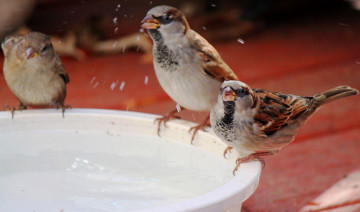Water is critical for attracting and nourishing birds in your yard. While not all birds may visit the same feeders or prefer the same foods, they all need water for drinking and bathing. It is easy to provide water for birds, and it can be surprising to see how many different species take advantage of the liquid refreshment.
Why Birds Need Water
Birds need water for several reasons. Drinking adequate amounts of water helps birds stay healthy and hydrated, promotes efficient blood circulation, improves digestion, and regulates body temperature. Some birds, however, get all the liquid they need in their diet from the foods they eat. Raptors get moisture from the blood of their prey, hummingbirds get water from floral nectar, and many desert birds, such as roadrunners, get moisture from plant buds and cactus blooms they may eat.
Even if birds don’t need water for drinking, however, they do need it for bathing. Regular baths help control feather parasites and keep a bird’s feathers in top condition for efficient, aerodynamic flight. Bathing also helps birds keep cool, which is critical during the hot summer months.
Types of Water for Birds
There are many different ways to offer water to birds in the yard, and birds will take advantage of different water sources. The most popular options include…
- Waterers – These closed-reservoir water sources, similar to hummingbird feeders, offer easy drinks, with the water released gradually through pressure and gravity. Smaller songbirds, such as finches and sparrows, happily visit hanging waterers.
- Bird Baths – The most familiar water source in a backyard, bird baths come in all sizes, shapes, and styles. These open-basin water sources offer space for birds to both drink and bathe, and many types of birds of all sizes will use bird baths.
- Misters – Light, fog-like sprays of water offer a fly-through bath and burst of cool for birds to enjoy. Smaller birds, particularly hummingbirds, appreciate misters, which can be positioned to spray foliage for a cool surface for larger birds to rub against.
- Drippers – A slow, steady drip of water into a basin or against a splash rock will attract the attention of many birds, especially ground species such as thrashers, doves, and many thrushes. Drippers can easily be positioned to drip into a bird bath, helping keep the basin full.
- Fountains – The noisy trickle and tinkle of water in a fountain can attract many birds as well as be a beautiful focal point in a bird-friendly yard. Simple fountains can be added to basins, or more elaborate fountains and weeping rocks are popular choices for many birds and birders.
- Ponds – A larger pond is a great water feature to attract ducks or wading birds such as rails, egrets, and herons. A naturalized pond with native plants will be best, but the edges should be shallow enough so birds can approach the water comfortably.
- Streams – A flowing stream is a more elaborate water feature but will be a magnet to many birds, particularly if the water trickles over shallow areas and flat rocks where birds can safely drink and bathe. All types of birds might visit even a small backyard stream.
Any water is better than no water at all for birds, but moving water, such as a dripper or fountain, is even better because the sparkles and noise of the motion will help attract more species. Flowing water, such as a larger fountain or stream, is best of all, as it will not only attract more birds, but will stay naturally cleaner and more appealing to all types of birds.
Tips for Bird-Friendly Water Sources
Water for birds must be clean and safe, as disease can easily spread through dirty water. To keep all water sources bird-friendly:
- Clean and disinfect water sources and wet surfaces every week with a weak chlorine solution, rinsing them thoroughly and allowing them to dry before refilling.
- Do not add any decontamination chemicals, algae blockers, de-icers, or insect repellants to water birds will drink or bathe in, as those chemicals can be toxic and deadly to birds.
- Clean and inspect filters, hoses, and pumps on moving water sources regularly to ensure their efficient operation, and replace worn out parts as needed.
- Use multiple water sources throughout the yard to attract the most birds and to appeal to birds with different drinking and bathing preferences.
- Keep basins no more than 2-3 inches deep so most birds can easily access the water. Just 1-2 inches deep is ideal for most smaller birds like finches and sparrows.
- Consider using heated water sources for winter birds, such as fully heated baths or immersion heaters rated for outdoor use, to provide a liquid source of water during cold months.
- Add blocks of ice to bird baths during the hottest months to keep the water cool and fresh, and to refill the basin slowly as water evaporates throughout the day.
The more water that is available, the more birds will visit the yard for refreshing drinks and baths. Many experienced birders are surprised at how many birds visit when new water sources are added, and using a variety of sources is a sure way to increase the size and diversity of any backyard flock.






Comments